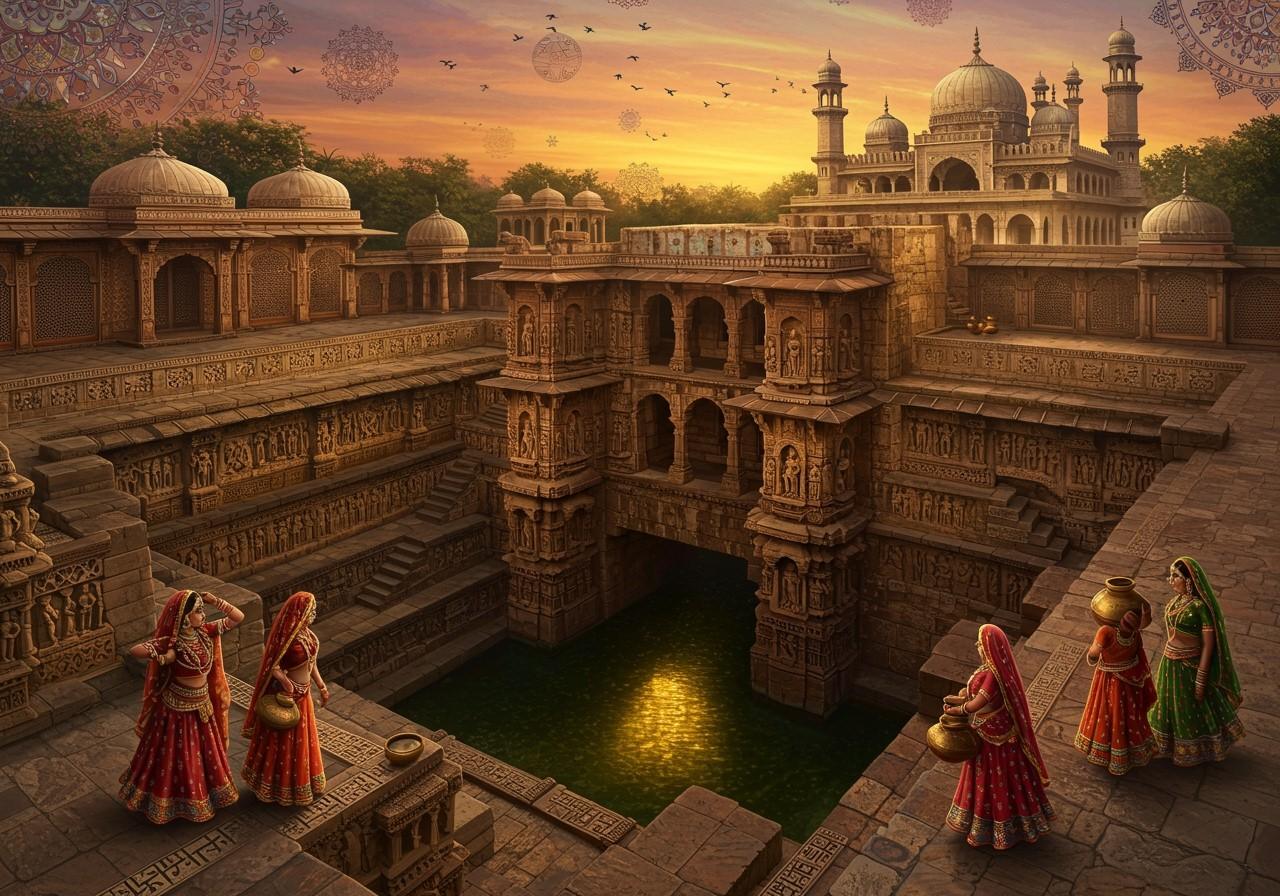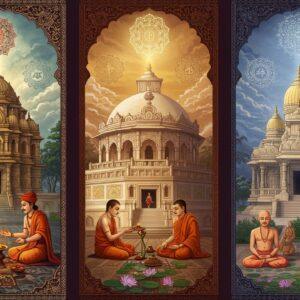
Gujarat, a western Indian state, is renowned for its vibrant history and diverse culture. As of March 2025, it proudly boasts four UNESCO World Heritage Sites, each whispering tales of its rich past and present. These sites offer a captivating glimpse into Gujarat’s historical and cultural significance. Understanding and preserving these landmarks contributes to the safeguarding of our global heritage.
Champaner-Pavagadh Archaeological Park
Designated a UNESCO World Heritage Site in 2004, Champaner-Pavagadh Archaeological Park showcases a captivating fusion of Hindu and Muslim architectural styles spanning the 8th to 14th centuries. The Kalika Mata Temple, nestled atop Pavagadh Hill, remains a significant pilgrimage destination. The park’s historical importance is further amplified by its role as a capital under the Khilji dynasty, underscoring its strategic location. The ancient water harvesting systems within the park are a testament to the advanced engineering prowess of the era. Grand mosques like the Jama Masjid stand as prominent features, admired for their intricate carvings and distinctive Indo-Islamic architecture. These elements solidify Champaner-Pavagadh’s position as a cornerstone of Gujarat’s heritage.
Rani ki Vav (The Queen’s Stepwell)
Rani ki Vav, an architectural marvel and a testament to ancient engineering, earned its UNESCO World Heritage Site status in 2014. Situated in Patan, this stepwell exemplifies Gujarat’s architectural brilliance. Commissioned in the 11th century by Queen Udayamati as a tribute to her husband, King Bhimdev I of the Solanki dynasty, Rani ki Vav showcases the intricate Maru-Gurjara style, celebrated for its elaborate carvings and sculptures. Descending its steps is akin to journeying through history, with walls adorned by depictions of religious, mythological, and secular narratives. This artistry reflects the exceptional craftsmanship of the time. More than just an architectural wonder, Rani ki Vav functioned as a sophisticated water management system, highlighting ancient ingenuity. Its practical utility, combined with its aesthetic beauty, makes it truly exceptional. Rediscovered in the 1980s after centuries buried beneath silt, Rani ki Vav revealed its hidden splendors to the world.
Historic City of Ahmedabad
Ahmedabad, India’s first UNESCO World Heritage City (designated in 2017), is a treasure trove of historical narratives. Founded in the 15th century by Sultan Ahmed Shah, the city boasts a rich tapestry of diverse architectural styles. Landmarks such as the Bhadra Fort and Sidi Saiyyed Mosque stand as silent witnesses to bygone eras. The city’s characteristic pol houses, with their intricate designs, showcase a harmonious blend of Hindu, Islamic, and Jain influences, reflecting cultural unity and architectural ingenuity. Ahmedabad’s historical prominence as a thriving trade hub contributed significantly to its prosperity. Beyond its architectural heritage, Ahmedabad pulsates with a vibrant cultural scene. Traditional crafts flourish, and the world-renowned kite festival attracts visitors from far and wide. The city skillfully balances the preservation of its heritage with the challenges of a modern metropolis, retaining its unique character.
Dholavira: A Harappan City
Dholavira, inscribed on the UNESCO World Heritage List in 2021, unveils the secrets of the ancient Indus Valley Civilization. Located on Khadir Bet in the Kutch district, this archaeological site showcases remarkable urban planning and sophisticated water systems, reflecting the advanced engineering skills of the Harappan civilization. Discovered in the 1960s, Dholavira offers valuable insights into the social and economic fabric of its time. Excavated artifacts reveal extensive trade and commerce networks. The city’s impressive water reservoirs and fortifications highlight sophisticated sustainability practices. Dholavira’s public spaces and expansive layout demonstrate early concepts of urbanization. Its contribution to our understanding of ancient life is invaluable, connecting visitors with a past that has shaped our present knowledge.
Shop Traditional Ritual Items for Gujarat’s Sacred Sites on Poojn.in
Poojn.in offers authentic puja items and ritual materials, allowing you to connect with Gujarat’s rich cultural heritage and UNESCO sites. Our curated collection includes:
- Pure copper items for temple offerings: Perfect for offerings at the Sun Temple, Modhera, these items add a traditional touch to your worship. Poojn.in sources high-quality copper goods for a truly authentic experience. Explore our copper collection.
- Traditional cotton prayer mats for meditation: Enhance your meditation practice at Rani ki Vav with these comfortable and authentic mats. Our mats are crafted from high-quality cotton for durability and a peaceful experience. Find your perfect prayer mat.
- Brass diyas and oil lamps for aarti ceremonies: Illuminate your aarti ceremonies with beautifully crafted brass diyas and oil lamps. We offer a variety of styles and sizes to suit your needs. Shop our diyas and lamps.
- Natural cotton wicks and pure ghee for temple rituals: Ensure the purity of your temple rituals with our natural cotton wicks and pure ghee. Sourced from trusted suppliers, these essentials uphold the sanctity of your practices. Browse our ritual essentials.
- Handcrafted incense and dhoop from Gujarat: Fill your space with the sacred fragrances of Gujarat with our handcrafted incense and dhoop. Experience the authentic aromas of traditional ingredients. Discover our incense collection.
- Authentic kumkum and rice for temple offerings: Offer traditional kumkum and rice at temples with our authentic selection. We ensure the quality and purity of these essential offerings. Learn more about temple offerings.
- Traditional puja thalis made by local artisans: Support local artisans and enhance your puja rituals with our handcrafted puja thalis. Each thali is uniquely designed and reflects traditional craftsmanship. Explore our puja thalis.
All Poojn.in products undergo rigorous quality checks and are sourced directly from verified vendors. We provide detailed product descriptions, usage instructions, and secure pan-India delivery. Visit www.poojn.in for our complete range of ritual items, helping you preserve and practice Gujarat’s sacred traditions. For bulk orders and temple supplies, contact our customer service team through the website. Poojn.in ensures you receive genuine ritual materials that maintain the sanctity of your prayers and offerings at Gujarat’s UNESCO heritage sites.
Celebrating Gujarat’s Heritage
Gujarat’s UNESCO World Heritage Sites offer more than just a glimpse into the past; they are living testaments to human creativity and resilience. From the intricate carvings of Rani ki Vav and the harmonious blend of architecture in Ahmedabad to the ancient wisdom of Dholavira, each site enriches our understanding of history. These treasures invite us to explore and appreciate the cultural mosaic that defines Gujarat. As we honor these sites, we celebrate the enduring spirit and ingenuity that continue to inspire generations. Embracing this heritage enriches our present and guides us towards preserving these marvels for the future.
FAQs About Gujarat’s UNESCO Sites
What is a UNESCO World Heritage Site? A UNESCO World Heritage Site is a landmark or area with cultural, historical, scientific, or natural importance recognized by the United Nations Educational, Scientific and Cultural Organization (UNESCO). These sites are legally protected by international treaties for their outstanding universal value.
How many UNESCO World Heritage Sites are there in Gujarat? As of March 2025, Gujarat is home to four UNESCO World Heritage Sites.
Why is Champaner-Pavagadh Archaeological Park significant? This park is significant for its unique blend of Hindu and Muslim architecture, illustrating the region’s rich and diverse history.
What makes Rani ki Vav a unique site? Rani ki Vav’s intricate stepwell design, adorned with beautiful sculptures, makes it a remarkable example of Maru-Gurjara architecture.
Why is the Historic City of Ahmedabad listed as a UNESCO World Heritage Site? Ahmedabad’s historical significance as a trade center and its unique Indo-Islamic architecture earned it the UNESCO World Heritage City designation.
What is special about Dholavira: a Harappan City? Dholavira stands out as one of the best-preserved urban settlements from the Indus Valley Civilization, offering invaluable insights into ancient city planning, architecture, and water conservation.
Can visitors access all these UNESCO sites in Gujarat? Yes, all four sites are open to visitors, providing unique opportunities to experience Gujarat’s rich history and culture.


